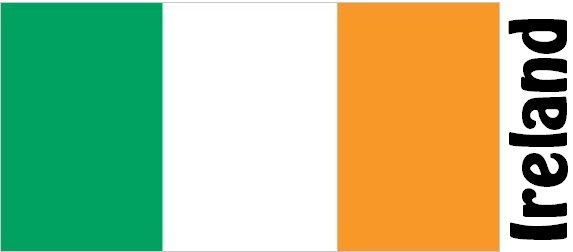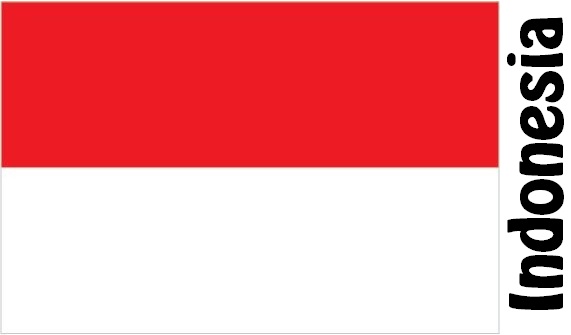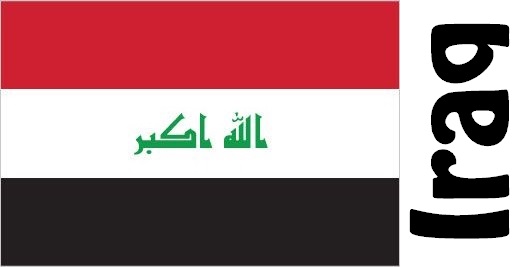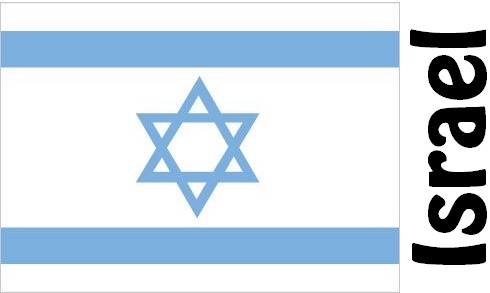Flags of Countries that Start with I

How many countries beginning with I? There are a total of 8 countries starting with letter I among the 193 countries in the world:
- Iceland
- India
- Indonesia
- Iran
- Iraq
- Ireland
- Israel
- Italy
Ireland

Ireland is an island nation in Western Europe, located to the west of Great Britain. The country is divided into two parts: the Republic of Ireland, which occupies most of the island, and Northern Ireland, which is part of the United Kingdom. Dublin, the capital, is a major cultural and economic center. Ireland has a rich history, influenced by Celtic traditions, early Christian missionaries, and its long struggle for independence from Britain. It became a republic in 1949, and today, it is known for its high standard of living, vibrant cultural scene, and strong economy, particularly in technology, pharmaceuticals, and agriculture. Ireland is famous for its landscapes, including rolling hills, rugged coastlines, and historical sites like ancient castles and monasteries. The majority of the population practices Roman Catholicism, and the Irish language, alongside English, is an official language, though English is more widely spoken.
Country Facts:
- Location: Western Europe, occupying most of the island of Ireland.
- Bordering Countries: Northern Ireland (part of the UK).
- Formal Country Name: Ireland (Éire).
- Capital: Dublin.
- Population: Approximately 5 million (2024 estimate).
- Language: Irish (official), English (official).
- Currency: Euro (EUR).
Country Facts – State Capital – Population Graph – Airports – Public Holidays – Embassies of Ireland – Embassies in Ireland – Import Regulations – Major Trade Partners – Major Imports – Major Exports
Iceland

Iceland is an island nation located in the North Atlantic Ocean, known for its striking volcanic landscapes, geothermal activity, and stunning natural beauty. Reykjavik, the capital and largest city, is the northernmost capital of a sovereign state in the world. Iceland is known for its glaciers, hot springs, geysers, and volcanoes, and it has a strong tradition of environmental sustainability, using geothermal energy for heating and power. Iceland was settled by Norse Vikings in the 9th century, and it was part of Denmark until gaining independence in 1944. Today, Iceland is one of the most developed countries in the world, with a strong economy based on tourism, fishing, renewable energy, and biotechnology. The country is famous for its progressive social policies, high standard of living, and commitment to gender equality. Icelandic, a North Germanic language, is the official language, and the majority of Icelanders are Lutheran. Iceland is not a member of the European Union but is part of the Schengen Area.
Country Facts:
- Location: North Atlantic Ocean.
- Bordering Countries: None (island nation).
- Formal Country Name: Iceland.
- Capital: Reykjavik.
- Population: Approximately 370,000 (2024 estimate).
- Language: Icelandic (official).
- Currency: Icelandic Króna (ISK).
Country Facts – State Capital – Population Graph – Airports – Public Holidays – Embassies of Iceland – Embassies in Iceland – Import Regulations – Major Trade Partners – Major Imports – Major Exports
Italy

Italy is a European country located in the southern part of the continent, with a boot-shaped peninsula extending into the Mediterranean Sea. It is bordered by France, Switzerland, Austria, and Slovenia to the north. Rome, the capital, is known for its ancient history, including landmarks like the Colosseum, the Roman Forum, and the Vatican City, the center of the Roman Catholic Church. Italy has a rich cultural heritage, with influential contributions to art, architecture, literature, and science. It was the birthplace of the Renaissance, with figures like Leonardo da Vinci, Michelangelo, and Galileo. Italy became a unified state in the 19th century and is now a republic with a parliamentary system. The country’s economy is diverse, with industries in manufacturing, fashion, tourism, agriculture, and high-tech products. Italian is the official language, and Roman Catholicism is the predominant religion.
Country Facts:
- Location: Southern Europe, in the Mediterranean.
- Bordering Countries: France, Switzerland, Austria, Slovenia.
- Formal Country Name: Italian Republic.
- Capital: Rome.
- Population: Approximately 60 million (2024 estimate).
- Language: Italian (official).
- Currency: Euro (EUR).
Country Facts – State Capital – Population Graph – Airports – Public Holidays – Embassies of Italy – Embassies in Italy – Import Regulations – Major Trade Partners – Major Imports – Major Exports
Ivory Coast

Ivory Coast is a republic in V-Africa. The country is located on the Gulf of Guinea. The central and northern parts of the country consist of highlighters with savanna. Lowland with rainforest in southern part. On the coast there are lagoons, mangrove swamps and sandy beaches.
The climate is tropical with most rainfall in S.
Agriculture is the most important profession. Among other things, cocoa, coffee, bananas, palm oil, pineapple and rubber for export. The most important natural resources are oil, diamonds, natural gas, timber and hydropower.
Since 2000, the Ivory Coast has been plagued by political crises, riots and bloody riots. Despite political turmoil, the Ivory Coast is one of the richest countries in Africa. The country was until 1960 a French colony.
Country Facts – State Capital – Population Graph – Airports – Public Holidays – Embassies of Ivory Coast – Embassies in Ivory Coast – Import Regulations – Major Imports – Major Exports
India

India is a vast and diverse country located in South Asia, bordered by Pakistan, China, Nepal, Bhutan, Bangladesh, and Myanmar. To the south, it is bounded by the Indian Ocean. New Delhi, the capital, is a major cultural, political, and economic center. India is the second-most populous country in the world, with over 1.4 billion people. It is known for its rich history, which includes ancient civilizations such as the Indus Valley Civilization, as well as its role as the birthplace of Hinduism, Buddhism, Jainism, and Sikhism. India gained independence from Britain in 1947, and since then, it has developed into one of the world’s largest economies, driven by technology, services, agriculture, and manufacturing. Despite its economic progress, India faces challenges such as poverty, inequality, and political tensions. Hindi and English are the official languages, and the country has a large number of regional languages. India is a secular country with Hinduism being the majority religion, followed by Islam, Christianity, and Sikhism.
Country Facts:
- Location: South Asia.
- Bordering Countries: Pakistan, China, Nepal, Bhutan, Bangladesh, Myanmar.
- Formal Country Name: Republic of India.
- Capital: New Delhi.
- Population: Approximately 1.4 billion (2024 estimate).
- Language: Hindi, English (official), and several regional languages.
- Currency: Indian Rupee (INR).
Country Facts – State Capital – Population Graph – Airports – Public Holidays – Embassies of India – Embassies in India – Import Regulations – Major Trade Partners – Major Imports – Major Exports
Indonesia

Indonesia is an archipelagic country in Southeast Asia, made up of over 17,000 islands, making it the largest archipelago in the world. The country is bordered by Malaysia to the west, the Philippines to the north, and Australia to the south. Jakarta, the capital, is the largest city and an economic and political center. Indonesia is known for its diverse culture, with over 300 ethnic groups and more than 700 languages spoken. The country has a rich history, influenced by Indian, Islamic, and European cultures. It was a Dutch colony until gaining independence in 1945. Indonesia’s economy is the largest in Southeast Asia, with major sectors including agriculture, mining (especially oil and gas), manufacturing, and tourism. The country is famous for its tropical climate, diverse ecosystems, and natural beauty, including beaches, rainforests, and volcanic landscapes. Indonesia is a predominantly Muslim country, but also has significant Christian, Hindu, and Buddhist minorities. Bahasa Indonesia is the official language.
Country Facts:
- Location: Southeast Asia, Pacific Ocean.
- Bordering Countries: Malaysia, Philippines, Australia, Papua New Guinea.
- Formal Country Name: Republic of Indonesia.
- Capital: Jakarta.
- Population: Approximately 275 million (2024 estimate).
- Language: Bahasa Indonesia (official).
- Currency: Indonesian Rupiah (IDR).
Country Facts – State Capital – Population Graph – Airports – Public Holidays – Embassies of Indonesia – Embassies in Indonesia – Import Regulations – Major Trade Partners – Major Imports – Major Exports
Iraq

Iraq is a country in the Middle East, bordered by Turkey to the north, Iran to the east, Kuwait to the southeast, Saudi Arabia to the south, Jordan to the southwest, and Syria to the west. Baghdad, the capital, is one of the oldest cities in the world and has historically been a center of learning, culture, and commerce in the Arab world. Iraq’s history dates back to ancient Mesopotamia, often referred to as the “cradle of civilization,” and it was home to some of the earliest urban societies, including the Sumerians, Babylonians, and Assyrians. Iraq gained independence from Britain in 1932 and became a republic in 1958. The country experienced a long period of instability, including the Iran-Iraq War in the 1980s, the Gulf War in 1991, and the 2003 invasion led by the United States. The economy is primarily based on oil exports, but Iraq faces significant challenges, including rebuilding infrastructure, political instability, and sectarian violence. Arabic and Kurdish are the official languages, and the majority of the population is Muslim, predominantly Shia.
Country Facts:
- Location: Middle East, bordering the Arabian Peninsula and Central Asia.
- Bordering Countries: Turkey, Iran, Kuwait, Saudi Arabia, Jordan, Syria.
- Formal Country Name: Republic of Iraq.
- Capital: Baghdad.
- Population: Approximately 43 million (2024 estimate).
- Language: Arabic (official), Kurdish (official).
- Currency: Iraqi Dinar (IQD).
Country Facts – State Capital – Population Graph – Airports – Public Holidays – Import Regulations – Major Imports – Major Exports
Iran

Iran, located in the Middle East, is bordered by Armenia, Azerbaijan, Turkmenistan, Afghanistan, Pakistan, and Turkey, as well as the Caspian Sea to the north and the Persian Gulf and Gulf of Oman to the south. Tehran, the capital, is a major political, economic, and cultural center. Iran is one of the oldest civilizations in the world, with a history that includes the ancient Persian Empire and influential dynasties such as the Safavids and the Qajars. The country became an Islamic Republic in 1979 after the revolution that overthrew the monarchy of Shah Mohammad Reza Pahlavi. Iran has a mixed economy based on oil exports, agriculture, and manufacturing, but it also faces significant economic challenges due to sanctions, political isolation, and internal instability. The majority of the population practices Shia Islam, and Persian (Farsi) is the official language. Iran has a rich cultural heritage, with contributions to literature, art, and science, particularly in the fields of mathematics and astronomy.
Country Facts:
- Location: Middle East, bordering Central Asia and the Arabian Peninsula.
- Bordering Countries: Armenia, Azerbaijan, Turkmenistan, Afghanistan, Pakistan, Turkey, Iraq.
- Formal Country Name: Islamic Republic of Iran.
- Capital: Tehran.
- Population: Approximately 87 million (2024 estimate).
- Language: Persian (Farsi).
- Currency: Iranian Rial (IRR).
Country Facts – State Capital – Population Graph – Airports – Public Holidays – Embassies of Iran – Embassies in Iran – Import Regulations – Major Imports – Major Exports
Israel

Israel is a country located in the Middle East, bordering Lebanon to the north, Syria to the northeast, Jordan to the east, Egypt to the southwest, and the Mediterranean Sea to the west. Jerusalem is the capital and one of the holiest cities in the world for Judaism, Christianity, and Islam. Israel was established in 1948 as a homeland for Jews following the end of British rule in Palestine and after the approval of the United Nations partition plan. Since its founding, Israel has been involved in multiple conflicts with its Arab neighbors over territorial disputes. Israel’s economy is highly developed, with significant industries in technology, defense, agriculture, and medicine. It is known for its innovation, particularly in the fields of high-tech, cybersecurity, and medical research. Hebrew is the official language, and the majority of the population practices Judaism, with sizable Muslim and Christian minorities. Israel is a parliamentary democracy and a member of the United Nations, although it faces ongoing conflict with Palestinians over territorial claims.
Country Facts:
- Location: Middle East, on the Mediterranean coast.
- Bordering Countries: Lebanon, Syria, Jordan, Egypt.
- Formal Country Name: State of Israel.
- Capital: Jerusalem.
- Population: Approximately 9.3 million (2024 estimate).
- Language: Hebrew (official), Arabic (official).
- Currency: Israeli New Shekel (ILS).
Country Facts – State Capital – Population Graph – Airports – Public Holidays – Embassies of Israel – Embassies in Israel – Import Regulations – Major Trade Partners – Major Imports – Major Exports













































